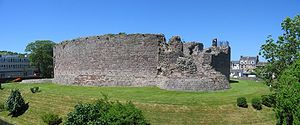Rothesay Castle
| Rothesay Castle | |
|---|---|
| Rothesay, Isle of Bute, Scotland | |

Rothesay Castle, with the 16th century forework in the centre, and the 13th century "Pigeon Tower" on the right
|
|

The 13th century curtain wall seen from the south-east, across the moat. The bases of the south-east and south-west towers can be seen.
|
|
| Coordinates | 55°50′11″N 5°03′18″W / 55.836461°N 5.055041°W |
| Type | Curtain Wall and Moat |
| Site information | |
| Owner | Historic Scotland |
| Controlled by | House of Stuart |
| Open to the public |
Yes |
| Condition | Ruined |
| Site history | |
| Built | 13thC |
| Built by | Alan, High Steward of Scotland or Walter Stewart |
| In use | Until 1660 |
| Materials | Stone |
Rothesay Castle is a ruined castle in Rothesay, the principal town on the Isle of Bute, in western Scotland. Located at NS086646, the castle has been described as "one of the most remarkable in Scotland", for its long history dating back to the beginning of the 13th century, and its unusual circular plan.
The castle comprises a huge curtain wall, strengthened by four round towers, together with a 16th-century forework, the whole surrounded by a broad moat. Built by the Stewart family, it survived Norse attacks to become a royal residence. Though falling into ruin after the 17th century, the castle was repaired by the Marquess of Bute before passing into state care in the 20th century.
The castle was built either by Alan fitz Walter, Steward of Scotland (died 1204), or by his succeeding son Walter (died 1246). During Alan's tenure, the family added the Isle of Bute to their lordship. A wooden castle was constructed first, but the stone circular curtain wall was in place by the 1230s, when the castle was attacked and taken by the Norwegian-backed fleet of Óspakr-Hákon, King of the Isles (died 1230). According to Hákonar saga Hákonarsonar, Óspakr's forces fought for three days to take the castle, breaking down part of the eastern wall by hewing the stone with their axes. This saga is the earliest recorded account of an assault on a Scottish castle. In 1263, Rothesay was taken again by the Norwegian forces under Hákon Hákonarson, King of Norway (died 1263) before the Battle of Largs. Although the Battle of Largs was indecisive, Hákon's campaign was unsuccessful, and effectively ended Norwegian authority in western Scotland.
...
Wikipedia

